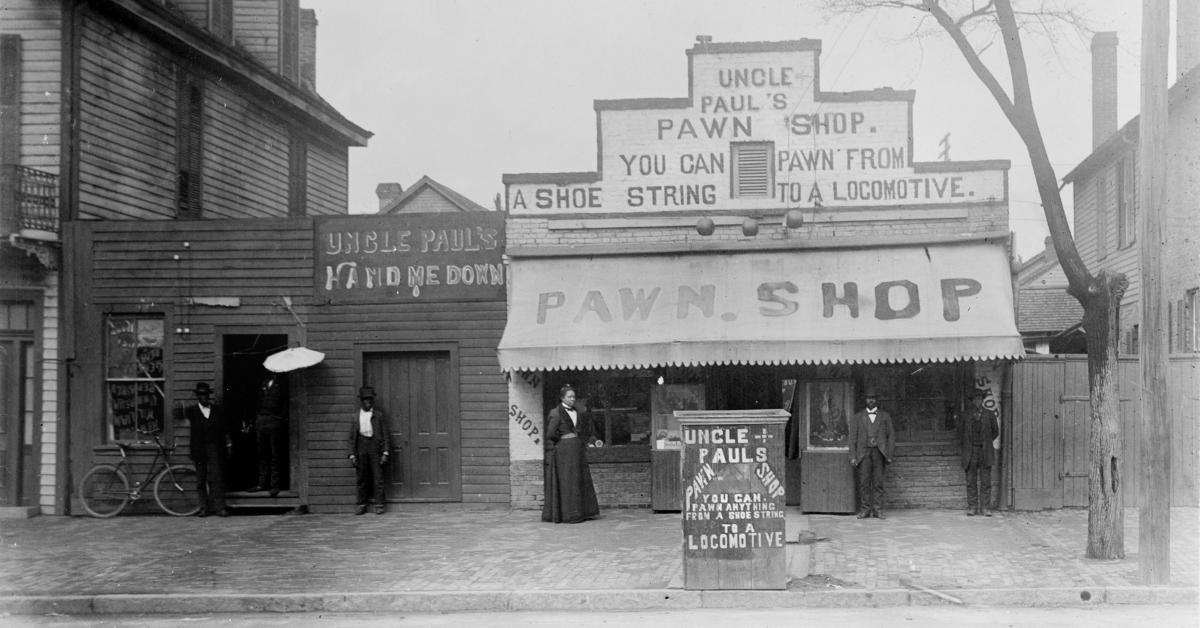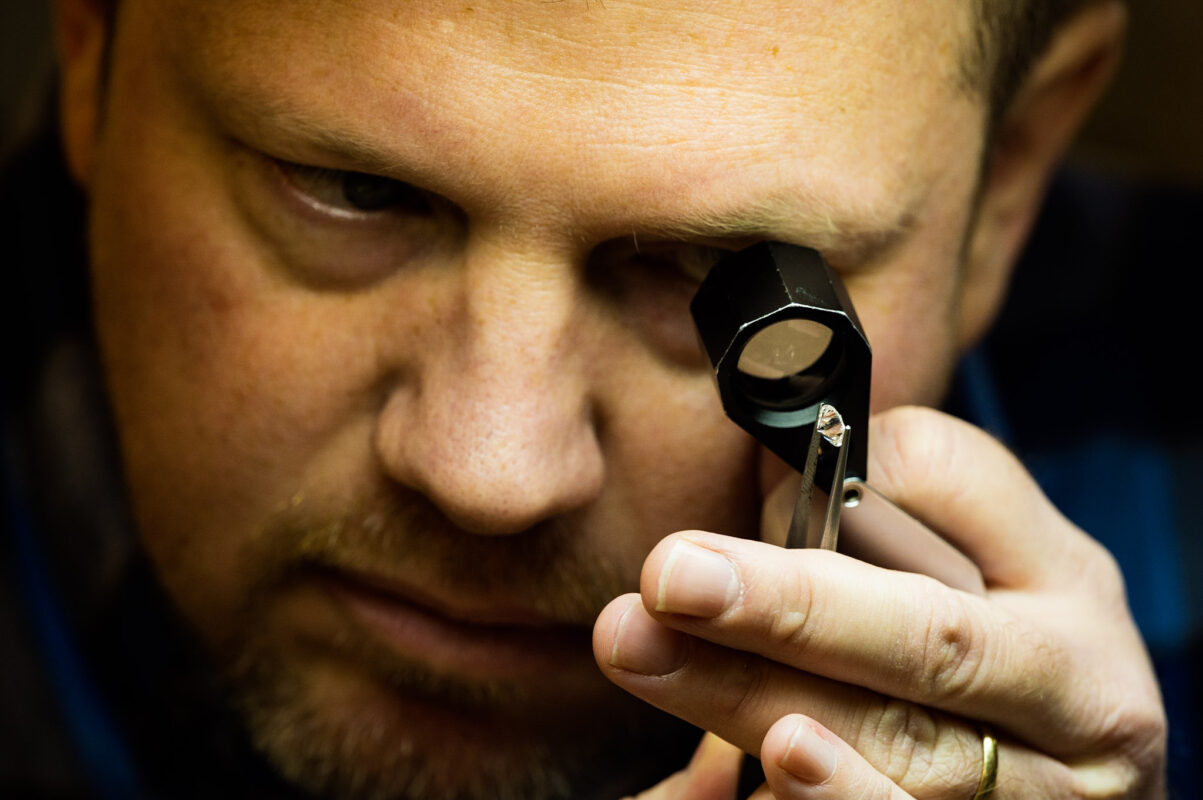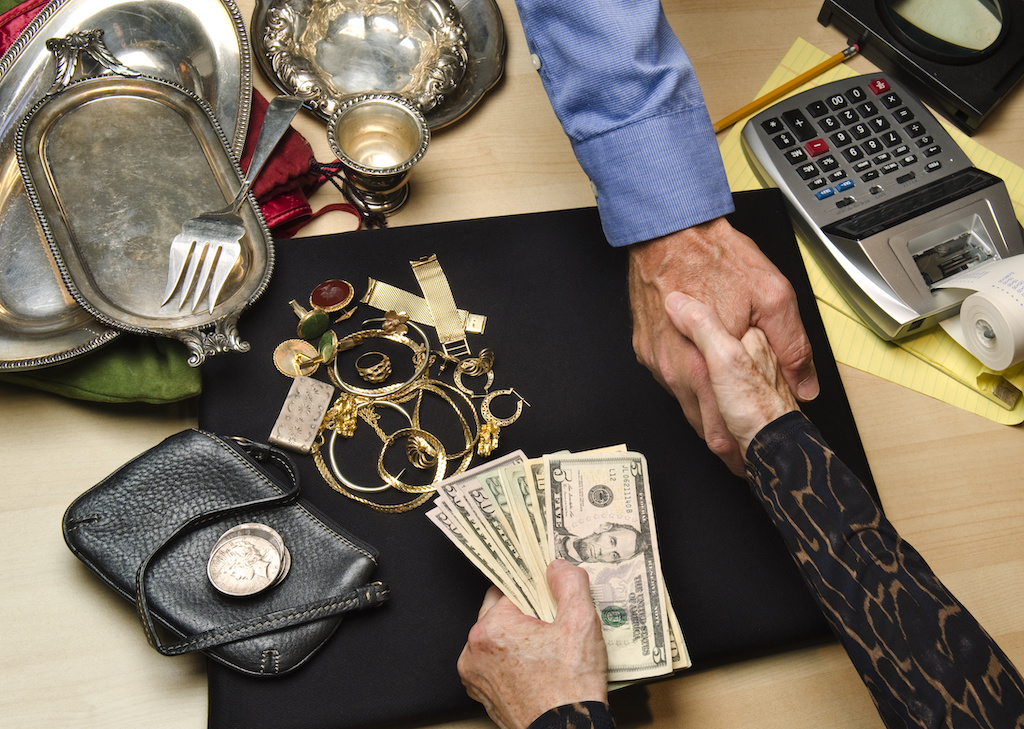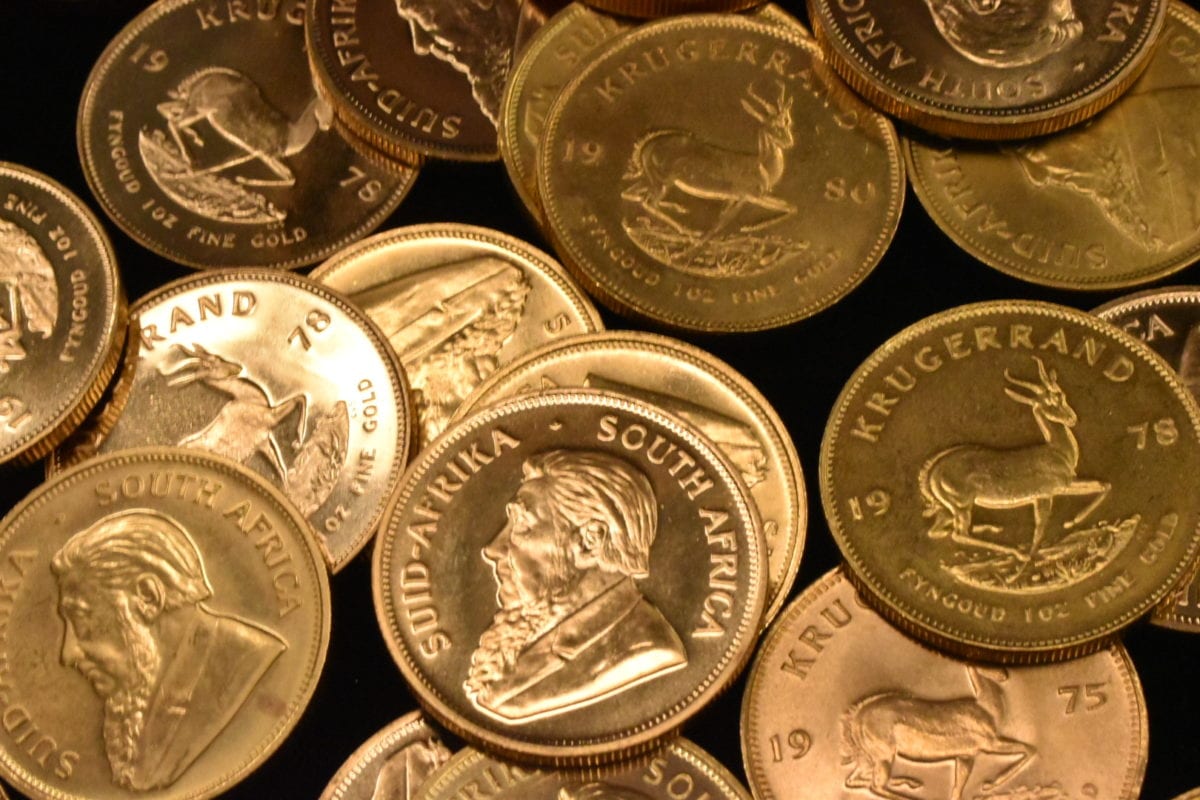When you first think of pawning jewelry or pawn shops, you may think of the TV show “Pawn Stars,” or maybe even a Quentin Tarantino film. However, pawn shops aren’t just an American practice, although more than 30 million Americans use pawn shops yearly. The practice of pawning has been around for centuries, dating back to ancient China. Today, it’s a $14.5 billion industry with 11,000+ pawnbrokers across the U.S. While pawning jewelry or other valuables might seem like a great way to get quick cash, educating yourself on the industry, the process, and its setbacks is essential. Here are some reasons why avoiding pawn shops might be in your best interest and some alternative options to get cash for your jewelry. What Are Pawn Shops, And How Do They Work? A pawn shop (also called a pawnbroker) is a business that loans money to people who bring in valuable items, which they then leave with the pawn shop. The valuables left behind are known as “collateral,” meaning security for the loan provided by the pawn shop. The person can get their valuable item(s) back from the pawn shop if they pay back the money the pawn shop loaned them with interest. However, suppose the person doesn’t repay the loan and interest within an agreed-upon timeline. In that case, the pawnbroker can sell the valuable item to another customer to get back the money the pawn shop loaned. How Do Pawn Shops Make Money? Pawn shops make money in two ways: (1) making personal loans and (2) selling unclaimed collateral items. Providing Personal Loans Pawn shops give out personal loans to individuals who relinquish custody of an item, such as jewelry or electronics. The amount a pawn shop is willing to lend is based on a few different factors: the value of the item, the pawnshop’s inventory at the time of the loan, and demand for the item. Since individuals seeking a pawn loan typically can’t qualify for a traditional bank loan, the risk of default is higher. That’s why pawn shops make loans with substantially higher interest rates than banks typically charge for personal loans. State law governs the amount of interest a pawn shop is allowed to charge. In Texas, the maximum pawn shop rate is 240% APR! That’s high! Reselling Pawn shops’ second primary income source is retail sales on unclaimed merchandise and items purchased outright from individuals. How Much Will Pawn Shops Give For Your Jewelry? If you are considering pawning jewelry, you might wonder how much pawn shops offer. Unfortunately, selling your jewelry to pawn shops guarantees the lowest amount of money in exchange for your items, thanks to the business model we outlined above. While pawn shops tend to offer more money to purchase items outright than to lend against them, it still will only get you about 50% of the value of your jewelry. Even if you need cash in a pinch, there are more lucrative ways to sell and get more out of the value of your jewelry. Alternatives to Pawning Jewelry If you want more money out of your jewelry, there are better ways! It also makes sense to outright sell jewelry you no longer want or need, rather than taking out a loan with a pawn shop. Those interest rates are no joke, especially in Texas! Here are some other, more lucrative, ways to sell your jewelry: Selling Online While this isn’t a great option if you need cash on the spot, you can sell your jewelry online to get more value out of your jewels. eBay is a great, safe option for everyday sellers. If you end up needing to do an in-person transaction, here are some do’s and don’ts to ensure your safety: DON’T agree to meet strangers alone. DON’T give out your address. DO meet in a safe, public place. DO accept cash only. Dallas Gold & Silver Exchange We’ve been around since the 1960s. We’ve stood the test of time by offering customers the most for their jewelry and being a trustworthy source of information. If you don’t believe us, shop around before you come to see us! We’ll give you the best offer and the best experience with our friendly, knowledgeable associates. You can bring your jewelry to any of our metroplex locations during our business hours at your convenience. No appointment is necessary. Want to learn more about the selling process at Dallas Gold & Silver Exchange? Let Loreina walk you through the easy process by clicking the video below!
Category Archives: Gold
Humans have spent thousands of years entranced by gemstones and precious metals. In some ways, we’re like fish – we’re attracted to shiny things! That’s why jewelry and gemology are such fascinating subjects with rich histories. It’s also why it’s so difficult to tell the real deal from the imitation. While costume jewelry and diamond alternatives are beautiful accessories, they won’t get you the cash that a *real* piece of jewelry will. Here are our tips to distinguish the real jewelry from the fake… and how to know when to seek a professional’s opinion. Precious Metals While we see today’s Olympic champions bite their gold medals, we don’t suggest this course of action for actually testing whether or not your gold is real. The history of the “gold bite test” dates back to merchants who would trade gold coins for goods. If their bite left teeth marks, the coin was deemed a fake since forgers would alloy their gold coins with other metals, including lead. In fact, some Olympians have even chipped their tooth whilst chomping down on their hard-earned medals! So, please (please) don’t do this. There’s a much easier (and dentist-approved) way to test the validity of the precious metals in your jewelry: look for stamps. Jewelry will often have teeny-tiny marks stamped on them in order to indicate their metals and fineness. We suggest getting our your readers for this. Here are some popular marks and what they mean: Metal US Fineness Marks International Fineness Marks 9- or 10-karat gold 9K or 10K 375 (37.5% pure gold) or 417 (41.7% pure gold) 14-karat gold 14K 585 (58.5% pure gold) 18-karat gold 18K 750 (75.0% pure gold) 24-karat gold 24K 999 (99.9% pure gold) Platinum PT 950 Sterling Silver 925 or sterling 925 Some jewelry pieces are unmarked, or the mark might be damaged. In this case, you can always bring the piece into one of our locations for a free check – no appointment is needed. Diamonds vs. Diamond Alternatives While metals have markings that can help the average consumer distinguish the real from the imitation, diamonds are a little trickier. An untrained eye can typically spot a real diamond, however there are a few diamond simulants that can dupe jewelry enthusiasts: Cubic Zirconia (or CZ) If you’ve ever shopped for an engagement or wedding ring at a big box store, you might know that CZ is used to simulate a diamond to visualize what it would look like in a certain setting. There are a few key differences to distinguish CZ from a real diamond. First, the dispersion of a CZ is much higher than that of a diamond. This means that the CZ will break up the light into a larger spectrum of colors than a diamond will. Second, most CZs are completely colorless. This is rare in real diamonds – a colorless diamond falls into the D color category on the diamond color scale. Even really stunning diamonds will have a twinge of yellow, while you won’t typically see this in CZs. Synthetic Moissanite This is a relatively newer diamond alternative that has recently gained popularity. Similar to the CZ, it also has more dispersion than that of a natural diamond. Natural moissanite is so rare, that if you’re looking at moissanite in jewelry, odds are that it’s synthetic. According to Brilliant Earth, “The most effective way to tell moissanite apart from a diamond is to use a loupe to look through the top, or the crown, of the jewel at an angle. You will see two slightly blurred lines that indicates a double refraction, an inherent quality of moissanite.” White Sapphire or White Topaz Unlike the previous alternative, white sapphire and white topaz will have less dispersion than a natural diamond. Glass Glass is more transparent than diamond. Another easy way to tell the difference is to check for inclusions Most diamonds will have inclusions that can either be seen with the naked eye or with a jeweler’s loupe. Glass will not have any inclusions as it will be hand-cut to simulate a diamond. Lab-Grown Diamonds You might be asking, “what about lab-grown diamonds?” Well, lab-grown diamonds technically are diamonds. However, since they’re man-made and manufacturing is ever-growing, they don’t fetch the same prices as natural diamonds since they are easier to come by. In fact, it’s often speculated that the value of these man-made alternatives will go down rather than up like their natural counterparts. Lab-grown diamonds can fool cheap diamond testers, so if you’re wondering whether or not yours was grown in a lab we recommend bringing it in for a closer look. Emeralds, Sapphires, and Other Gemstones There aren’t really any great DIY tests for gemstones, so the simple answer to this is just to bring it in to one of our GIA Graduate Gemologists. They’ll easily be able to distinguish real gemstones from imitations. While we don’t typically purchase pearls, there is a DIY method to check if they’re real or not. While we don’t encourage using your teeth to test gold, it is okay to use your teeth to test pearls. Simply rub the pearl against your teeth! If it feels grainy, you’ve got a genuine pearl on your hands. If it feels smooth, odds are that it’s not real. Other Tips to Distinguish Real Jewelry From The Fake We always recommend bringing in an item for our experts to take a look at, especially if you wish to sell it. Whether you sell it to us or not is up to you – and we’ll look at it for free, so there’s nothing to lose. You can visit us at any of our DFW locations in Dallas, Euless, Frisco, Grand Prairie, Grapevine, and Lewisville – no appointment needed.
Selling your jewelry is all about getting the best deal. To get the most out of your unwanted jewelry, you need to know what the jewelry is worth and where you should and should not sell it. If you’re not careful about where you choose to sell it, you may end up losing a lot of money. Here are a few places to avoid when selling your jewelry: Online Yes, that means websites like eBay, Craigslist, and Facebook Marketplace that tend to look for rock-bottom prices. It is easy to get caught up in the promising offers and ease of selling online, but it is very difficult to know if you are getting an accurate or even fair amount for your valuables. Not to mention, placing your gold in the mail to a non-reputable seller is a move you don’t want to make. Cash for Gold Scams People rely on places like this for some quick cash, but are often disappointed with the results. Today conducted an experiment to see how accurate gold buying companies are by selling 450 dollars worth of gold to 10 different buyers. The closest offer was $393.36 (sellyourgold.com), however, the offers quickly plummeted. Cash4Gold offered a mere $76.89 for the gold, and hardgoldcash.com offered an insulting $38.25, only 8% of the gold’s real market value. They went on to shop their gold back from these places. The prices were over $300. If you mail in gold and aren’t happy with the check, immediately request your gold be returned. Pawn Shops Pawn shops are a common choice for quick cash, but it can be difficult for consumers to get the best values — especially for jewelry. Sometimes you can negotiate with shop owners to get a better deal. Even so, pawn shops are likely to pay just 30%-60% of the item’s estimated value. No matter which type of store you choose, you should get at least three estimates — and more for high-value items. At Dallas Gold and Silver Exchange, we’re public, trustworthy, and we offer a fast and easy selling process. We pay top dollar for North Texans’ gold, silver, jewelry, rare coins and have hundreds of positive reviews.
At Dallas Gold & Silver Exchange, we want you to feel comfortable selling your gold and for you to be sure you’re getting the best offer in Dallas. That’s why our experts have put together a list of tips for selling your gold so you can feel like an expert, too! Here’s 4 things you should know before selling your gold: What “karat” actually means. When we use “karat” to refer to gold, we are referring to its purity. Pure gold, or 24-karat, is too soft to use in most jewelry. So, gold is alloyed with other metals to increase its strength so that it can be used in fine jewelry. Most importantly, the karat purity of your gold will effect the price. To check the purity of your gold yourself, look for the gold hallmark stamped into your jewelry. While you can always check our tracker to see what the price of gold is, this is referring to 24-karat (pure) gold. To get the price of 14-karat or 18-karat gold commonly used in jewelry, you need to both weigh your item and do a little arithmetic. For example, if your item is 14-karat gold, and the current price of gold is $1,600 per ounce, or $51.45 per gram ($1,600/31.1), then the price of your scrap gold is $51.45 x .585 = $30.10 per gram. Gold Hallmark Karat Indicators: Karat Karat Mark European Mark Percent Pure Gold 10-karat 10K 417 41.7% 14-karat 14K 585 58.5% 18-karat 18K 750 75.0% 22-karat 22K 917 91.7% Of course, we can help you with all of this when you bring your items in for a quote. This is just for your reference! Beware of illegitimate buyers. There are many sellers out there who claim to be experts and won’t give you a fair value for your items just to make a quick buck. To avoid these, only sell to legitimate jewelry stores, not pawn shops or random pop-up buyers. When you believe you’ve found a reputable buyer, make sure to check with the Better Business Bureau and ensure they have a good grade. Is it scrap? Or perhaps much more? Research whether or not your gold items are more valuable as they are than if they were melted down as scrap. You never know how much an item is really worth until you do a little digging! Of course, our experts at Dallas Gold & Silver Exchange can help you with this and give you the most accurate quote in Dallas. We really know our gold! However, if you’re aware that your gold item has some history, let us know so we can get you the best price. Shop around! Don’t believe we’ll get you the best price for your gold? That’s okay — we’ll let our offers speak for themselves! Check with different (legitimate) gold buyers around Dallas to ensure you’re getting the best offer. If you find a better offer than ours, we’ll match it. Simple as that!
Over the past few years, the Marie Kondo method of tidying up has exploded in popularity across America. The Japanese tidying guru, as a result of her wildly popular book and Netflix series, has a method that is convincing (typically materialistic) Americans to get rid of dust-gathering junk like never before. If you’re unfamiliar with the Marie Kondo method of tidying up, here’s a simplified explanation: the first steps involve going through your home, category by category, and placing all of your belongings in the center of the space. You then pick up each item, consider it and ask yourself, “does this item spark joy?” If the answer is yes, you keep the item since it makes you happy. If the answer is no, the item is either discarded, donated or sold. Simple as that! Of course, Marie Kondo has methods for keeping your space tidy by folding and organizing, but the real magic happens when you face the challenge of getting rid of the clutter that doesn’t spark joy. There’s a reason the Marie Kondo method is so popular — it feels great to purge old junk cluttering up your home! At Dallas Gold & Silver Exchange, we want to help you tidy up AND make some cash at the same time by buying any gold, silver, fine jewelry or bullion that may be sitting stagnant in your home! How do I tidy up with Dallas Gold & Silver Exchange? Marie Kondo recommends going through your clutter by category, beginning with clothing and ending with mementos. Depending on if you have nostalgia associated with your items made of fine metals, you can organize them in either category. If your chosen items no longer spark joy, bring them to Dallas Gold & Silver Exchange for a fair price estimate. If you decide to sell your items to us, we’ll give you cash on the spot! It’s a win-win for you and your wallet. Why tidy up with Dallas Gold & Silver Exchange? We have an A+ rating from the Better Business Bureau, so you can be 100% sure you’re getting the best price for your items. Our experts know everything there is to know about gold, silver, bullion and diamonds. The price of gold and silver fluctuates, so check out our tracker before you come in. If you’re not sure how much you should be selling for, feel free to shop around and get multiple estimates for your items. If someone else gives you a better deal, we’ll match it. So, are you ready to tidy up and clear out some of those family heirlooms or fine metal goods you never use? Bring them on in to Dallas Gold & Silver Exchange for cash today!
There are plenty of opinions about whether this is the right time to buy gold, which is down about 35 percent from its 2011 peak and has resisted predictions of a comeback. Barron’s, the business magazine, checks in this week in with a long, balanced examination of pros and cons, and comes down on the plus side. “U.S. stocks are at record levels exactly at a time when global stress—trade tensions, populist nationalism, and the like—appears to be growing,” writes Andrew Bary. “This may be an opportune moment for investors to shift at least a portion of their portfolios to gold: both the metal and depressed mining shares.” Read the cover story – headlined “Gold Is Cheap. Inflation Is Coming. You Do the Math” – here, and decide for yourself.
Need another reason to love gold? Everybody’s favorite precious metal might revolutionize the solar energy industry. Scientists at Hokkaido University in Japan have developed a photoelectrode that uses gold to convert far more sunlight to energy than is currently possible. The scientific reports are full of terms like “localized plasmon resonance” and “inlaid depth traps,” but here are the basics: Most solar panels can only convert 15-20 percent of sunlight into electricity. That’s enough to power a boom in solar energy, but scientists are working to make panels more efficient. The team at Hokkaido took the semiconductor, which turns sunlight into electricity by agitating electrons, and sandwiched it between a layer of gold nanoparticles (that’s a fancy word for incredibly tiny) and a 100-nanometer thick layer of gold (that’s one-thousandth the width of a strand of hair). That’s not much gold, but it’s enough to create a mirror effect, trapping the rays and allowing the semiconductor to absorb much more light and convert it to energy. The researchers were amazed that the 15-20 percent efficiency soared to more than 85 percent. The discovery, published in the journal Nature Nanotechnology, is still in the experimental stage, but appears to have great potential. “Using very small amounts of material, this photoelectrode enables an efficient conversion of sunlight into renewable energy, further contributing to the realization of a sustainable society,” the authors wrote. That’s good news on two fronts: thanks to gold, the more can save on energy bills, the more we can save at Dallas Gold & Silver Exchange.







